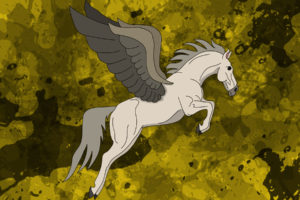Pegasus (peh-gah-suhs)
 Pegasuses were flying horses. Their coats were mostly white or thundercloud gray to enable them to better blend in with their surroundings while in flight. One of the easier flying mounts to control, the pegasus would only allow a rider of supreme intellect aboard their backs. To be permitted to ride a pegasus mare was incredibly flattering as mares possessed a greater acuity for judging intelligence than stallions. The longest recorded flight time for a pegasus was just under three hours because they needed to land
Pegasuses were flying horses. Their coats were mostly white or thundercloud gray to enable them to better blend in with their surroundings while in flight. One of the easier flying mounts to control, the pegasus would only allow a rider of supreme intellect aboard their backs. To be permitted to ride a pegasus mare was incredibly flattering as mares possessed a greater acuity for judging intelligence than stallions. The longest recorded flight time for a pegasus was just under three hours because they needed to land
periodically to rest. Larger herds could usually be found in highland areas.
Biology
Specific terms and specialized language were used to describe pegasuses different life stages, colors and breeds.
Lifespan and life stages
Depending on breed, management and environment, the modern domestic pegasus had a life expectancy of 25 to 30 years. Uncommonly, a few lived into their 40s and, occasionally, beyond.
The following terminology was used to describe pegasuses of various ages:
- Colt: A male pegasus under the age of four. A common terminology error was to call any young pegasus a “colt”, when the term actually only referred to young male horses.
- Filly: A female pegasus under the age of four.
- Foal: A pegasus of either sex less than one year old. A nursing foal was sometimes called a suckling and a foal that has been weaned was called a weanling. Most domesticated foals were weaned at five to seven months of age, although foals could be weaned at four months with no adverse physical effects.
- Gelding: A castrated male pegasus of any age.
- Mare: A female pegasus four years old and older.
- Stallion: A non-castrated male pegasus four years old and older.
- Yearling: A pegasus of either sex that was between one and two years old.
Size and measurement
The height of pegasuses was usually measured at the highest point of the withers, where the neck meets the back. This point was used because it was a stable point of the anatomy, unlike the head or neck, which moved up and down in relation to the body of the steed.
The height of pegasuses was often stated in units of hands and inches: one hand was equal to 4 inches (101.6 mm). The height was expressed as the number of full hands, followed by a point, then the number of additional inches, and ending with the abbreviation “h” or “hh” (for “hands high”). Thus, a pegasus described as “15.2 h” is 15 hands plus 2 inches, for a total of 62 inches (157.5 cm) in height.
The size of pegasuses varied by breed, but also was influenced by nutrition. Light riding pegasuses usually ranged in height from 14 to 16 hands (56 to 64 inches, 142 to 163 cm) and could weigh from 380 to 550 kilograms (840 to 1,210 lb). Larger riding pegasuses usually started at about 15.2 hands (62 inches, 157 cm) and often were as tall as 17 hands (68 inches, 173 cm), weighing from 500 to 600 kilograms (1,100 to 1,320 lb).
